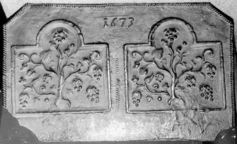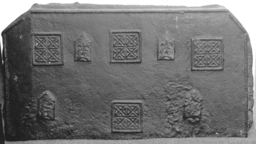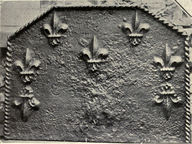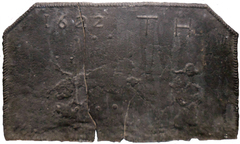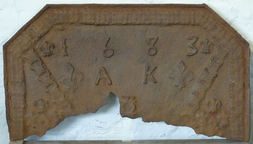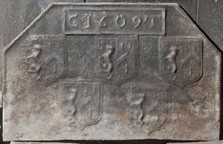-
129
Description: Canted rectangle; twisted rope edging (top and sides); date stamp top centre; arched rectangular style fireback with cavetto-moulded edge and fructed ‘vine’ plant design, impressed twice; vertical twisted rope length between. Damage to bottom corners.
Notes: A composite fireback using the impressions of another fireback repeated for a symmetrical design. Formerly part of the Ade Collection (from Grove Hill, Hellingly, Sussex).
Inscription: 1673
- Decoration tags:
- rectangular with canted top corners (shape)
- rope (edging)
- composite
- date stamp
- text
- plants
- objects
Manufactured: in 1673 in the Weald area of England.
Current location: Hastings Museum and Art Gallery, John's Place, Bohemia Road, Hastings, East Sussex, England.
Museum number: HASMG: 1952.51.65 (part of the Hastings Museum museum group)
- Attached to series:
- Composite firebacks
- Small cavetto series
-
151
Description: Canted rectangle; ovolo moulded edging (top and sides); eight shields of Ayloffe impaling Sulyard in three rows 3-2-3. Top right corner missing
Notes: Ayloffe: sable, a lion rampant Or, collared gules, between three crosses formy of the second; Sulyard: argent, a chevron gules between three pheons inverted sable. William Ayloffe (c1535-1584) of Bretons, Hornchurch, Essex, Justice of the Court of Queen’s Bench, married (c1560) Jane, dau. of Sir Eustace Sulyard, of Runwell, Essex. There is a large number of variants using the same shields. Formerly part of the Ade Collection (from Grove Hill, Hellingly, Sussex).
Arms: Ayloffe impaling Sulyard (William Ayloffe of Bretons, Hornchurch)
- Decoration tags:
- rectangular with canted top corners (shape)
- ovolo (edging)
- carved stamps
- armorial
Manufactured: in the early-17th century in the Weald area of England.
Current location: Hastings Museum and Art Gallery, John's Place, Bohemia Road, Hastings, East Sussex, England.
Museum number: HASMG: 1952.51.43 (part of the Hastings Museum museum group)
- Attached to series:
- Ayloffe series
- Personal armorial firebacks
-
170
Description: Canted rectangle; twisted rope edging (top and sides); square stamp with fillet edge and four diagonally quartered squares, repeated three times along top and once centre bottom; square stamp with triangular top containing intaglio fleur de lys, two positioned between squares in top row, and two separated by square below. Formerly part of the Ade Collection (from Grove Hill, Hellingly, Sussex).
Notes: The smaller stamp could also be interpreted as a face in caricature with a pointed hat, perhaps a bishop's mitre. It appears that more iron was poured into the mould than its depth allowed for, resulting in the considerable thickness of the casting.
- Decoration tags:
- rectangular with canted top corners (shape)
- rope (edging)
- carved stamps
Manufactured: in the mid- to late-16th century possibly in the Weald area of England.
Current location: Hastings Museum and Art Gallery, John's Place, Bohemia Road, Hastings, East Sussex, England.
Museum number: HASMG: 1952.51.22 (part of the Hastings Museum museum group)
- Attached to series:
- Food mould stamp firebacks
- Crossed square Wealden series
-
318
Description: Canted rectangle; twisted rope edging (top and sides); symmetrical arrangement of a fleur-d-lys stamp repeated seven times (2-3-2), with the middle one of the three slight above the other two, and the bottom two inverted immediately below the outer two of the three.
Notes: The style of the fleurs is identical to those on two firebacks decorated with firedogs bearing the initials, HN, and the crossed staple badge of the Nevills; Henry Nevill occupied Mayfield furnace from about 1585 until 1599.
- Decoration tags:
- rectangular with canted top corners (shape)
- rope (edging)
- carved stamps
- heraldic
Manufactured: in the late-16th century possibly at Mayfield Furnace in the Weald area of England.
Current location: not known.
Citation: Hayden, A., 1912, Chats on Cottage and Farmhouse Furniture (Unwin, London).
- Attached to series:
- Henry Nevill series
-
921
Description: Canted rectangle; twisted rope edging (top and sides); central arrow-shaped design formed of three repeated rope lengths.
Notes: The arrow design probably has an apotropaic (evil-averting) purpose, perhaps intended as the initials VV for 'virgo virginum'.
- Decoration tags:
- rectangular with canted top corners (shape)
- rope (edging)
- simple stamps
- apotropaic
- objects
Manufactured: in the 16th century in the Weald area of England.
Current location: in private hands, Heathfield, East Sussex, England.
- Attached to series:
- Rope design firebacks
-
1038
Description: Canted rectangular shape; edging formed of lengths of cross-cut dowel (top and sides); inscription across upper centre probably formed of thumb prints; the last digit of the date may be an incomplete 5 rotated left.
Notes: A crudely executed fireback; the cross-cut dowel used for the edging has not been noted on any other fireback.
Inscription: 16 wo 15[?]
- Decoration tags:
- rectangular with canted top corners (shape)
- cross-cut dowel (edging)
- simple stamps
- individual letters
- individual numbers
- text
Manufactured: in the early-17th century in the Weald area of England.
Current location: Herstmonceux Castle, Herstmonceux, East Sussex, England.
- Attached to series:
- Date & initials firebacks
-
1176
Description: Canted rectangular shape; twisted rope edging (top and sides); top left, date 1622; top right, initials T H.
Notes: The surface excrescences on the lower half of the fireback are likely to have resulted from the displacement of the casting sand by the pouring of the iron. Formerly at Marden Hill House, Tewin, Hertfordshire. There is no basis for the suggestion by Hertford Museum that this fireback might have been cast by a Thomas Hogge.
Inscription: 1622 T H
- Decoration tags:
- rectangular with canted top corners (shape)
- rope (edging)
- simple stamps
- carved stamps
- individual letters
- individual numbers
- text
Manufactured: in 1622 possibly in the Weald area of England.
Current location: Hertford Museum, 18 Bull Plain, Hertford, Hertfordshire, England.
Museum number: HETFM2893.1 (part of the Hertford Museum museum group)
- Attached to series:
- Date & initials firebacks
-
323
Description: Canted rectangle; simulated rope edging; otherwise plain.
Copies of this fireback are known.
- Decoration tags:
- rectangular with canted top corners (shape)
- simulated rope (edging)
- whole carved pattern
Manufactured: in the mid-20th century in England.
Current location: Hardy's Cottage, Higher Bockhampton, Dorset, England.
Museum number: 426390 (part of the National Trust museum group)
- Attached to series:
- Base boards
-
832
Description: Canted rectangular; astragal edging (top and sides), inside of which are repeated panels carved with overlapping fleurs-de-lys; upper centre, date evenly spaced in individual numerals; below date, initials evenly spaced in individual letters; at each end of date, single small fleur-de-lys stamp; at each end of initials, large hollow fleur-de-lys; diagonally from each lower corner of canting, line of six squared cross stamps; in bottom corners, triad of small fleur-de-lys stamps each enclosing a large fleur below; bottom centre, woodblock stamp.
Notes: The repeated fleur panels are likely to have derived from furniture. Varied use of the same stamps are on other firebacks, including one dated 1667 at Upper End Farm, Hope Mansell, Herefordshire.
Inscription: 1683 / AK
- Decoration tags:
- rectangular with canted top corners (shape)
- astragal (edging)
- carved stamps
- individual letters
- individual numbers
- heraldic
- text
- objects
Manufactured: in 1683 in the Forest of Dean area of England.
Current location: not known.
-
1126
Description: Canted rectangular shape; twisted rope edging (top and sides); cavetto-moulded-edged rectangle top centre, enclosing date between initials CT; five shields of Ayloffe impaling Sulyard in two rows (3-2); Ayloffe: sable, a lion rampant Or, collared gules, between three crosses formy of the second; Sulyard: argent, a chevron gules between three pheons inverted sable.
Notes: William Ayloffe (c1535-1584) of Bretons, Hornchurch, Essex, Justice of the Court of Queen’s Bench, married (c1560) Jane, dau. of Sir Eustace Sulyard, of Runwell, Essex. The initials 'CT' are likely to be those of Charles Tyler, a founder whose working life and that of his family have strong parallels with the occurrence of these firebacks. The smallest dated example in this series.
Inscription: C.1.6.0.9.T
Arms: Ayloffe impaling Sulyard (William Ayloffe of Bretons, Hornchurch)
- Decoration tags:
- rectangular with canted top corners (shape)
- rope (edging)
- carved stamps
- individual letters
- individual numbers
- heraldic
- armorial
- text
Manufactured: in 1609 possibly at Bedgebury Furnace, Goudhurst in the Weald area of England.
Current location: The Crown Inn, The Green, Horsted Keynes, West Sussex, England.
- Attached to series:
- Ayloffe series
- Personal armorial firebacks
